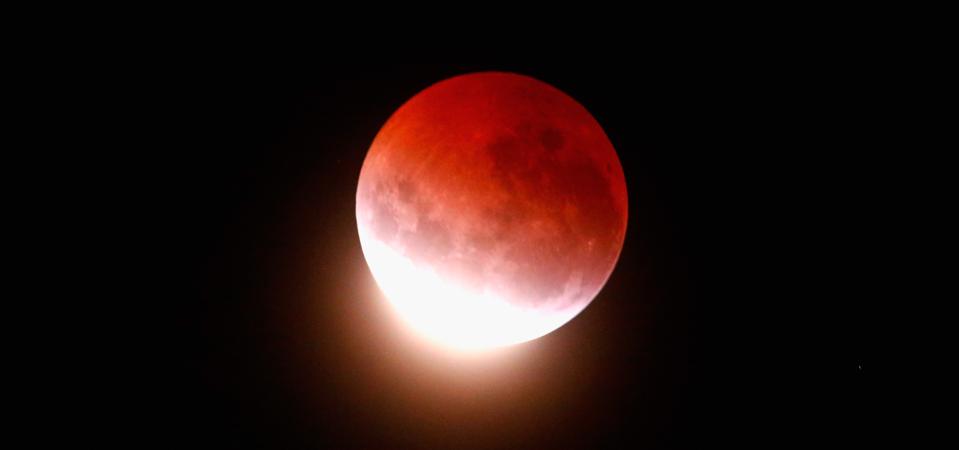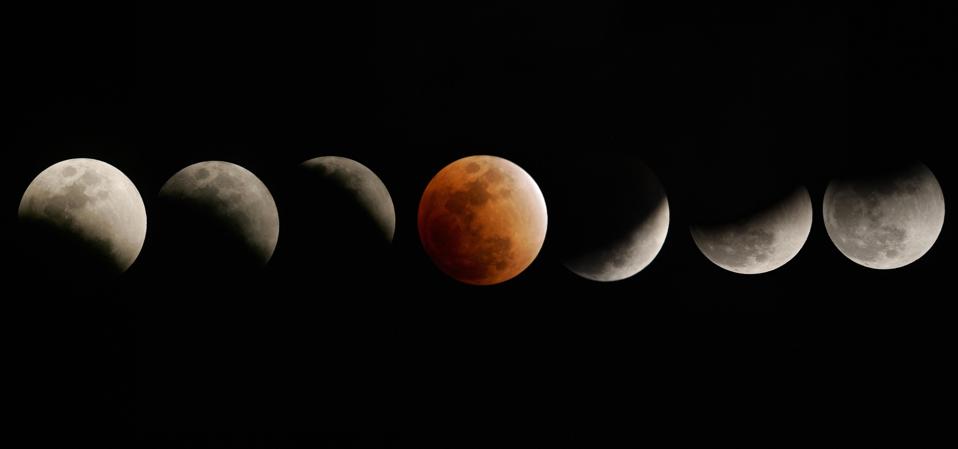
When is the next “Blood Moon?” In the early hours of Friday, November 19, 2021 a lunar eclipse—also known as a “Blood Moon—will be visible from the Americas, northern Europe, eastern Asia, Australia and the Pacific.
During the event a smaller-than-usual full Moon—November’s “Beaver Moon”—will enter Earth’s shadow for the longest time this century. However, it’s technically “only” a partial lunar eclipse. But did you know that it will also set-up a total solar eclipse in early December?
Here’s everything you need to know about the “Blood Moon” including exactly when, where and how to see it from North America.
Explained: ‘Blood Moon’ partial lunar eclipse
On Friday, November 19, 2021 those in North America, South America, Australia and East Asia will see the full Moon turn red.
However, it won’t go completely red. In fact, during the event only 97% of the Moon will enter Earth’s shadow in space, leaving a tiny portion still illuminated by the Sun.
A total lunar eclipse occurs when a full Moon passes through Earth’s shadow in space. Each month the New Moon passes roughly between the Earth and the Sun and then orbits to the other side of Earth to the Sun to become a full Moon.
When those alignments are precise they cause either a solar or lunar eclipse.
The Moon’s orbit is titled in respect to the ecliptic—the Sun’s apparent path through our daytime sky—so only very occasionally does a New Moon eclipse the Sun (a total solar eclipse) and/or a full Moon travel through the Earth’s shadow (a total lunar eclipse).
What will happen on Friday, November 19, 2021 is a full Moon traveling through the edge of the Earth’s shadow.

Explained: why the ‘Blood Moon’ will last so long
At three hours 28 minutes and 23 seconds this lunar eclipse will be the longest lunar eclipse between 2001 and 2100 according to NASA. That’s because the “Beaver Moon” is going to be the smallest full Moon of the year. Why? Because the Moon will be slightly further away than on average.
The Moon has an elliptical orbit that sees it reach a close point (perigee or “supermoon”) and a far point (apogee) each month. This month happens to feature the farthest apogee Moon, which is a mere 1.7 days after the eclipse.
Since it’s far away the Earth’s shadow is larger, so it will take longer to travel through it—it’s therefore an unusually deep lunar eclipse.
Explained: why the ‘Blood Moon’ will turn red
During the Moon’s long journey through Earth’s shadow on Friday November 19, 2021 the only light that will reach the lunar surface will first have been filtered through Earth’s atmosphere.
Short-wavelength blue light from the Sun hits molecules in Earth’s atmosphere and scatters, but longer-wavelength red and orange light mostly travels right through, striking fewer molecules. So the dominant color of light we’ll see on the Moon for that short time will be red.
The physics is the same as for a sunset or sunrise. In fact, during a lunar eclipse the effect is like thousands of sunrises and sunsets being projected onto the lunar surface.
However, 2.6% of the Moon won’t enter Earth’s shadow. Located on the southern limb of the Moon, it will remain lit by the Sun while most of the lunar disk will turn red.

What will happen during the ‘Blood Moon’ partial lunar eclipse
A partial lunar eclipse is really three eclipses in one—and it happens in five acts. The event begins when the full Moon enters the Earth’s outer shadows—its penumbra (a penumbral lunar eclipse). It then begins to enter Earth’s inner shadow—its umbra—and as it does so it begins to turn red (a partial lunar eclipse). Once the whole of the Moon is inside the umbra that’s totality—the Moon will have turned 97.4% red.
The entire event then goes into reverse, with the Moon exiting the umbra, then the penumbra.
Here’s the global schedule according to eclipse expert Fred Espenak:
- Penumbral lunar eclipse 06:02-07:18 UTC (76 minutes – full Moon drops in brightness ... you can miss this part.)
- Partial lunar eclipse 07:18-09:02 UTC (104 minutes – full Moon begins to turn reddish ... the sight of the Moon slowly turning reddish is incredible!)
- Greatest eclipse (near-totality) 09:02 UTC (greatest eclipse – full Moon is 97.4% red ... if you only want a glimpse of the “Blood Moon” this is when to see it!)
- Partial lunar eclipse 09:02-10:47 UTC (105 minutes – full Moon begins to turn grey ... this is also a grand sight—it’s Earth’s shadow moving across the lunar surface!)
- Penumbral lunar eclipse 10:47-12:03 UTC (76 minutes – full Moon remains muted in brightness ... you can also miss this part.)
So the duration of the partial lunar eclipse is a whopping three hours 28 minutes and 24.1 seconds!

When is the ‘Blood Moon’ partial lunar eclipse where I live?
This is a global event visible to everyone on the night-side of Earth, but when you can see it depends, of course, on your timezone. So check a schedule for your location and consult an interactive map of the event.
When is the next lunar eclipse?
The next lunar eclipse will occur on May 16, 2022, when a 100% reddish “Blood Moon” will be visible in North America for 84 minutes—and it’s a total lunar eclipse!
However, this eclipse season is not done yet because the partial lunar eclipse will be followed on the next New Moon—on Saturday, December 4, 2021—with that most dramatic kind of eclipse of all, a total solar eclipse. It will be visible only to a few thousands eclipse-chasers mostly on cruise ships in Antarctica.
Disclaimed: I am the editor of WhenIsTheNextEclipse.com
Wishing you clear skies and wide eyes.







